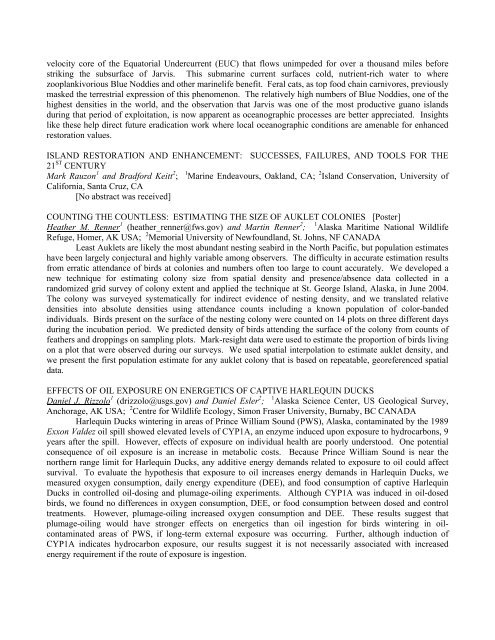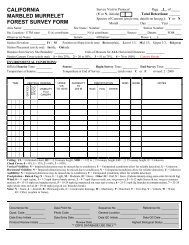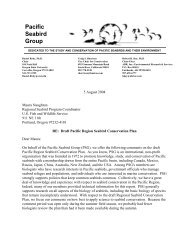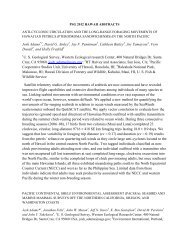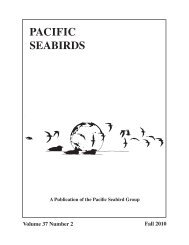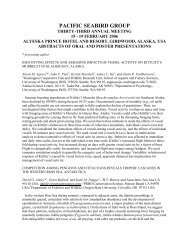abstracts of oral and poster presentations - Pacific Seabird Group
abstracts of oral and poster presentations - Pacific Seabird Group
abstracts of oral and poster presentations - Pacific Seabird Group
You also want an ePaper? Increase the reach of your titles
YUMPU automatically turns print PDFs into web optimized ePapers that Google loves.
velocity core <strong>of</strong> the Equatorial Undercurrent (EUC) that flows unimpeded for over a thous<strong>and</strong> miles before<br />
striking the subsurface <strong>of</strong> Jarvis. This submarine current surfaces cold, nutrient-rich water to where<br />
zooplankivorious Blue Noddies <strong>and</strong> other marinelife benefit. Feral cats, as top food chain carnivores, previously<br />
masked the terrestrial expression <strong>of</strong> this phenomenon. The relatively high numbers <strong>of</strong> Blue Noddies, one <strong>of</strong> the<br />
highest densities in the world, <strong>and</strong> the observation that Jarvis was one <strong>of</strong> the most productive guano isl<strong>and</strong>s<br />
during that period <strong>of</strong> exploitation, is now apparent as oceanographic processes are better appreciated. Insights<br />
like these help direct future eradication work where local oceanographic conditions are amenable for enhanced<br />
restoration values.<br />
ISLAND RESTORATION AND ENHANCEMENT: SUCCESSES, FAILURES, AND TOOLS FOR THE<br />
21 ST CENTURY<br />
Mark Rauzon 1 <strong>and</strong> Bradford Keitt 2 ; 1 Marine Endeavours, Oakl<strong>and</strong>, CA; 2 Isl<strong>and</strong> Conservation, University <strong>of</strong><br />
California, Santa Cruz, CA<br />
[No abstract was received]<br />
COUNTING THE COUNTLESS: ESTIMATING THE SIZE OF AUKLET COLONIES [Poster]<br />
Heather M. Renner 1 (heather_renner@fws.gov) <strong>and</strong> Martin Renner 2 ; 1 Alaska Maritime National Wildlife<br />
Refuge, Homer, AK USA; 2 Memorial University <strong>of</strong> Newfoundl<strong>and</strong>, St. Johns, NF CANADA<br />
Least Auklets are likely the most abundant nesting seabird in the North <strong>Pacific</strong>, but population estimates<br />
have been largely conjectural <strong>and</strong> highly variable among observers. The difficulty in accurate estimation results<br />
from erratic attendance <strong>of</strong> birds at colonies <strong>and</strong> numbers <strong>of</strong>ten too large to count accurately. We developed a<br />
new technique for estimating colony size from spatial density <strong>and</strong> presence/absence data collected in a<br />
r<strong>and</strong>omized grid survey <strong>of</strong> colony extent <strong>and</strong> applied the technique at St. George Isl<strong>and</strong>, Alaska, in June 2004.<br />
The colony was surveyed systematically for indirect evidence <strong>of</strong> nesting density, <strong>and</strong> we translated relative<br />
densities into absolute densities using attendance counts including a known population <strong>of</strong> color-b<strong>and</strong>ed<br />
individuals. Birds present on the surface <strong>of</strong> the nesting colony were counted on 14 plots on three different days<br />
during the incubation period. We predicted density <strong>of</strong> birds attending the surface <strong>of</strong> the colony from counts <strong>of</strong><br />
feathers <strong>and</strong> droppings on sampling plots. Mark-resight data were used to estimate the proportion <strong>of</strong> birds living<br />
on a plot that were observed during our surveys. We used spatial interpolation to estimate auklet density, <strong>and</strong><br />
we present the first population estimate for any auklet colony that is based on repeatable, georeferenced spatial<br />
data.<br />
EFFECTS OF OIL EXPOSURE ON ENERGETICS OF CAPTIVE HARLEQUIN DUCKS<br />
Daniel J. Rizzolo 1 (drizzolo@usgs.gov) <strong>and</strong> Daniel Esler 2 ; 1 Alaska Science Center, US Geological Survey,<br />
Anchorage, AK USA; 2 Centre for Wildlife Ecology, Simon Fraser University, Burnaby, BC CANADA<br />
Harlequin Ducks wintering in areas <strong>of</strong> Prince William Sound (PWS), Alaska, contaminated by the 1989<br />
Exxon Valdez oil spill showed elevated levels <strong>of</strong> CYP1A, an enzyme induced upon exposure to hydrocarbons, 9<br />
years after the spill. However, effects <strong>of</strong> exposure on individual health are poorly understood. One potential<br />
consequence <strong>of</strong> oil exposure is an increase in metabolic costs. Because Prince William Sound is near the<br />
northern range limit for Harlequin Ducks, any additive energy dem<strong>and</strong>s related to exposure to oil could affect<br />
survival. To evaluate the hypothesis that exposure to oil increases energy dem<strong>and</strong>s in Harlequin Ducks, we<br />
measured oxygen consumption, daily energy expenditure (DEE), <strong>and</strong> food consumption <strong>of</strong> captive Harlequin<br />
Ducks in controlled oil-dosing <strong>and</strong> plumage-oiling experiments. Although CYP1A was induced in oil-dosed<br />
birds, we found no differences in oxygen consumption, DEE, or food consumption between dosed <strong>and</strong> control<br />
treatments. However, plumage-oiling increased oxygen consumption <strong>and</strong> DEE. These results suggest that<br />
plumage-oiling would have stronger effects on energetics than oil ingestion for birds wintering in oilcontaminated<br />
areas <strong>of</strong> PWS, if long-term external exposure was occurring. Further, although induction <strong>of</strong><br />
CYP1A indicates hydrocarbon exposure, our results suggest it is not necessarily associated with increased<br />
energy requirement if the route <strong>of</strong> exposure is ingestion.


